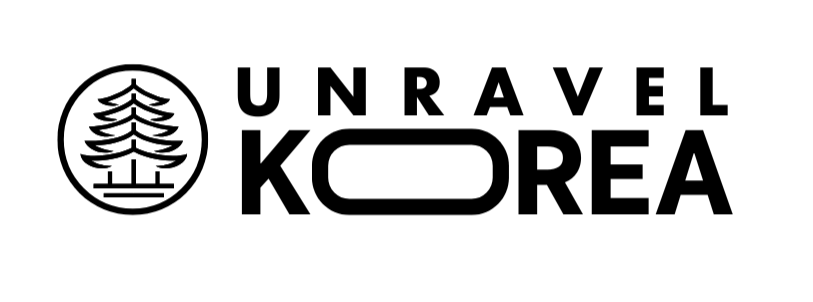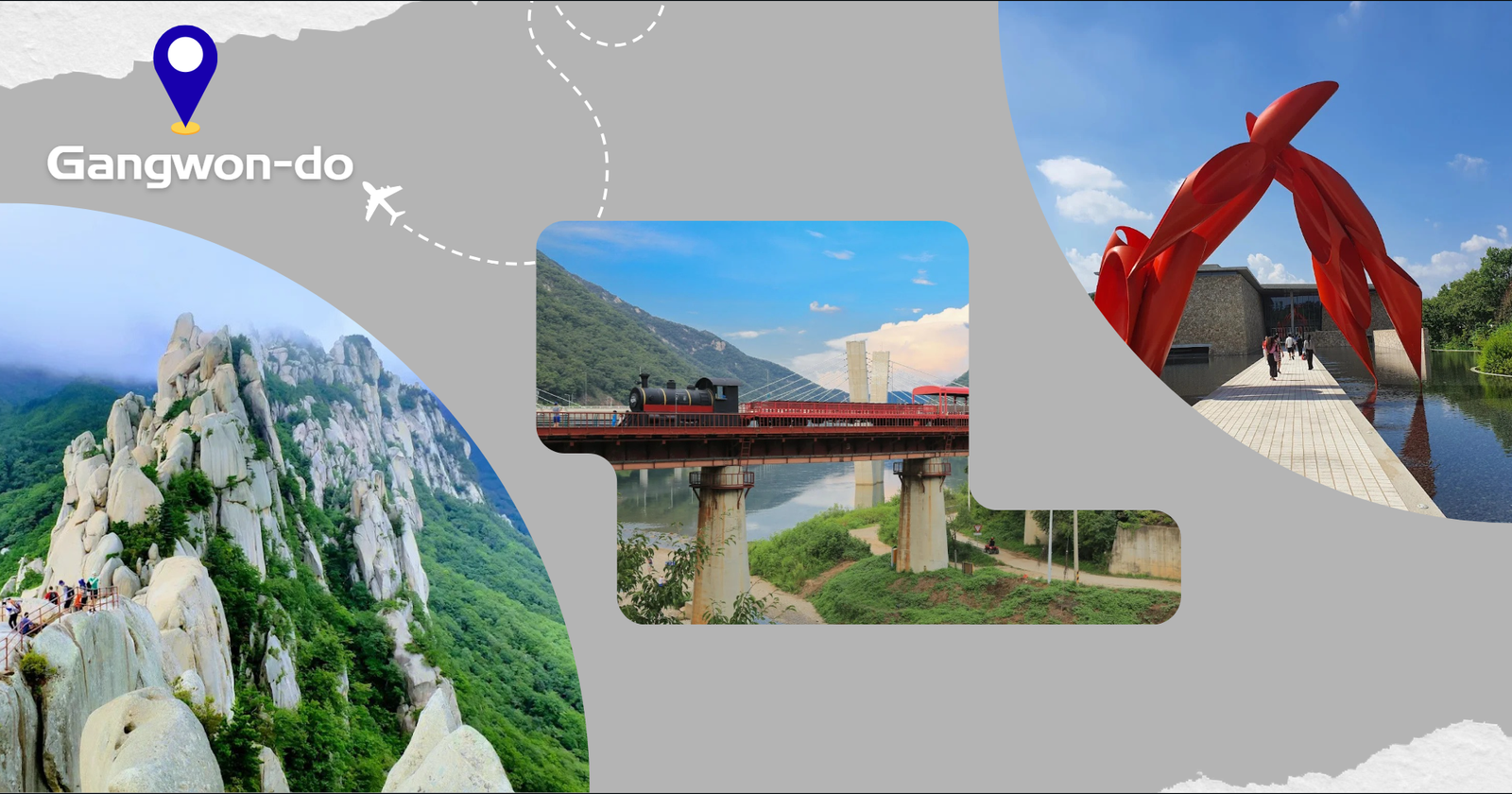Gangwon-do is South Korea’s most mountainous and scenic province, stretching along the east coast from the DMZ in the north to beautiful beaches in the south.
Known for dramatic peaks, pristine coastline, winter sports, and natural beauty, Gangwon-do offers Korea’s best outdoor adventures and scenic landscapes.
What is Gangwon-do Famous For?
Seoraksan National Park: Korea’s most famous mountain with stunning granite peaks and fall foliage
Winter Sports: Home to Pyeongchang, host of the 2018 Winter Olympics, with world-class ski resorts
East Coast Beaches: Beautiful sandy beaches along the East Sea (Sea of Japan)
Fresh Seafood: Coastal cities famous for raw fish, squid, and seafood markets
Natural Beauty: Mountains, caves, valleys, and forests covering 80% of the province
DMZ Proximity: Northern areas offer unique border tourism experiences
Coffee Culture: Gangneung’s famous coffee beach scene
Clean Air: Least polluted region in Korea with fresh mountain air
Top Things to Do in Gangwon-do
Ulsanbawi Rock
The crown jewel of Seoraksan National Park, Ulsanbawi is a dramatic rock formation reaching 873 meters high with six massive granite peaks.
Location: Seorak-dong, Sokcho (Outer Seoraksan area)
Height: 873 meters above sea level
Famous features:
Six towering granite pinnacles
Breathtaking panoramic views
Ancient Buddhist temple (Heundeulbawi Rock Temple)
808-step metal staircase to summit
Hiking details:
- Distance: 4 km round trip from cable car or 6 km from park entrance
- Time: 2-3 hours round trip (steep climb)
- Difficulty: Moderate to challenging (many stairs)
- Best season: Autumn for fall colors, spring for greenery
Park entrance fee: 3,500 KRW adults
Cable car: 11,000 KRW round trip (optional, reduces hiking time)
Hours: Park opens at sunrise, closes at sunset
Views from summit: 360-degree panoramas of Seoraksan’s peaks, East Sea coastline, and surrounding valleys. The metal staircases are steep but well-maintained with railings.
Tips: Start early to avoid crowds, wear proper hiking shoes, bring water and snacks. Autumn weekends can be extremely crowded.
Naksansa Temple
A historic Buddhist temple perched on coastal cliffs overlooking the East Sea, combining spiritual significance with stunning ocean views.
Location: Yangyang-gun (30 minutes north of Sokcho)
Founded: 671 AD during Silla Dynasty
Significance: One of Korea’s most important coastal temples
Main attractions:
Haesugwaneumsang: 15-meter tall white Goddess of Mercy statue facing the ocean
Uisangdae Pavilion: Octagonal pavilion on cliff edge with ocean views
Seven-story stone pagoda
Main temple halls with elaborate paintings
Coastal walking paths
Pine forest temple grounds
Entrance fee: 3,000 KRW adults
Hours: 6 AM – 7 PM
Time needed: 1-2 hours
Best time: Sunrise or sunset for dramatic lighting
The temple was partially destroyed by 2005 forest fire but has been beautifully restored. The combination of traditional architecture, spiritual atmosphere, and crashing ocean waves creates a unique temple experience unlike mountain temples.
Access: Bus from Sokcho (30 minutes), taxi (15,000-20,000 KRW from Sokcho)
Sokcho Beach
Sokcho’s main urban beach offering classic Korean beach culture with backdrop of Seoraksan mountains.
Length: 1.2 km of white sand
Water: Calm, shallow, ideal for swimming
Facilities: Showers, restrooms, lifeguards (summer), beach equipment rentals
Beach activities:
Swimming and sunbathing (July-August peak season)
Beach volleyball
Water sports rentals
Evening walks along illuminated boardwalk
Fresh seafood restaurants lining the beach
Nearby attractions:
- Sokcho Tourist & Fishery Market: Fresh seafood, 5 minutes walk
- Sokcho Expo Park: Walking paths and lighthouse, adjacent to beach
- Abai Village: Historic North Korean refugee village, 10 minutes
Sokcho Beach is less crowded than Busan’s Haeundae but offers stunning mountain-meets-ocean scenery unique to Gangwon-do. The fresh seafood restaurants serve catches brought directly from nearby port.
Hwanseongul Cave
One of Korea’s largest and most impressive limestone caves, featuring massive chambers and spectacular rock formations.
Location: Samcheok-si (southern Gangwon-do)
Length: 6.5 km total (1.6 km open to public)
Height: Entrance at 560 meters elevation
Age: Formed over 500 million years
Cave features:
Enormous caverns (some 100 meters wide)
Stunning stalactites and stalagmites
Underground waterfalls and streams
Cathedral-like chambers
Colorful LED lighting (tastefully done)
Entrance fee: 5,000 KRW adults, 3,500 KRW children
Hours: 9 AM – 5 PM (last entry 4 PM)
Time needed: 1.5-2 hours including monorail ride
Temperature: Constant 8-12°C year-round
Access:
Monorail ride up the mountain (included in ticket): 15 minutes
Walking path available (40 minutes uphill): Free but strenuous
Most visitors take monorail up, walk down or take monorail both ways
The cave’s massive scale and natural formations are genuinely impressive, ranking among Asia’s finest show caves. The monorail journey through the forest adds to the adventure.
Gwongeumseong Fortress
Ancient mountain fortress ruins accessed by cable car, offering spectacular views of Seoraksan and the East Sea.
Location: Outer Seoraksan, Sokcho (near Ulsanbawi)
History: Fortification from Goryeo Dynasty (918-1392 AD)
Current state: Ruins with restored sections and viewing platforms
Access:
Seorak Cable Car: 11,000 KRW round trip, 6 minutes to summit
Hiking trail: Free but steep 1 hour climb
At the fortress:
- Ruins of ancient stone walls
- Multiple viewing platforms with panoramas
- Heundeulbawi (Rocking Rock) – giant boulder that wobbles when pushed
- Photo zones with mountain backdrop
- Small snack shops
Views:
- Seoraksan’s granite peaks
- East Sea coastline
- Sokcho city
- Ulsanbawi Rock formation
Best time: Early morning or weekdays to avoid cable car queues
Combine with: Ulsanbawi hike and Shinheungsa Temple for full day
The cable car ride itself is an attraction, offering aerial views of dense forest and rocky peaks. Autumn foliage season (October) creates stunning scenery but expect long waits.
Alpaca World
A unique animal theme park where visitors can interact with alpacas and other animals in a picturesque mountain setting.
Location: Hongcheon-gun (inland Gangwon-do)
Size: Large hillside ranch with multiple zones
Animals: Alpacas, llamas, rabbits, deer, ponies, sheep, birds
Activities:
Alpaca feeding: Feed alpacas by hand (food provided)
Walking with alpacas on leashes
Photo opportunities with friendly animals
Petting zoo areas
Animal shows and performances
Sky walking course with mountain views
Camping facilities
Entrance fee: 15,000 KRW adults, 12,000 KRW children
Hours: 10 AM – 6 PM (last entry 5 PM)
Time needed: 2-3 hours
Best for: Families with children, animal lovers, unique Instagram content
Facilities:
Cafes and restaurants
Gift shops with alpaca merchandise
Photo zones throughout
Clean restrooms and baby facilities
Seasons: Open year-round, beautiful in all seasons
- Spring: Baby animals born
- Summer: Green mountains, outdoor activities
- Autumn: Fall colors backdrop
- Winter: Snowy landscape (magical setting)
Access:
- From Seoul: 2 hours by car
- Limited public transportation – car rental or tour recommended
- Often combined with nearby Vivaldi Park ski resort
Alpaca World became famous through Korean TV shows and offers a genuinely fun, family-friendly experience. The alpacas are well-cared-for and surprisingly friendly, making it Instagram gold.
Here you can explore what best things to do in Busan, Jeju Island, Daegu and must visit places in Seoul
How to Get to Gangwon-do
To Sokcho (Seoraksan area)
From Seoul (200 km):
- Express bus: Seoul Express Bus Terminal, 2.5 hours, 16,000-20,000 KRW
- By car: 2.5-3 hours via Yeongdong Expressway
- Frequency: Buses every 30-40 minutes
To Gangneung (beach & coffee area)
From Seoul (230 km):
- KTX train: 2 hours, 25,000-35,000 KRW (fastest option)
- Express bus: 3 hours, 15,000-20,000 KRW
- By car: 3 hours via Yeongdong Expressway
To Pyeongchang (ski resorts & Alpaca World)
From Seoul (150 km):
- Express bus: 2-2.5 hours, 12,000-16,000 KRW
- By car: 2 hours via Yeongdong Expressway
- Resort shuttles: Available from Seoul during ski season
To Samcheok (Hwanseongul Cave area)
From Seoul (270 km):
- Express bus: 3.5 hours, 20,000-25,000 KRW
- From Gangneung: Local bus 1.5 hours, 8,000 KRW
Getting Around Gangwon-do
Car rental: Highly recommended – attractions are spread out
Intercity buses: Connect major towns but limited to rural areas
Taxis: Available in cities, expensive for long distances
Tour packages: Many Seoul companies offer Gangwon-do day tours
Travel Tips
Car recommended: Gangwon-do is large and spread out; car provides flexibility
Duration: Minimum 2 days, ideally 3-4 days to see highlights
Autumn crowds: Seoraksan in October is extremely crowded – arrive very early or visit weekdays
Winter preparation: Bring warm clothes; mountains are much colder than Seoul
Hiking gear: Proper shoes essential for mountain areas
Language: Very limited English outside major hotels
Cash: Many rural restaurants and shops don’t accept cards
Gangwon-do offers Korea’s most spectacular natural scenery, from granite peaks and limestone caves to pristine beaches and adorable alpacas.
Whether seeking mountain adventures, coastal relaxation, winter sports, or unique animal experiences, this diverse province provides unforgettable experiences in Korea’s great outdoors.

